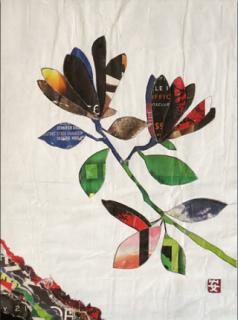As It Is: And/Or/Neither/Nor Work by Andrew (A01) Owen

Magnolias II
Andrew (A01) Owen was a huge influence on me during the writing of The Blue Light Project. His street activity was high during the months I was writing and researching the book, primarily in the form of 1:1 scale “re-photo-cubic-surfaces”. I became very intrigued by this practice and by this artist. Over the following years, I got to know him a little better, and began to realize that he had 20 years of intense production already behind him, dozens of interesting and beautiful works, not an eclectic gathering as a person might first mistakenly think, but bound thematically. I was able appreciate this more fully when he mounted a show at Marion Scott Gallery last year. I wrote a review of that show for Canadian Art, which I’m re-running below.
Check out more of Andrew’s work at A01creative.

—-
As It Is: And/Or/Neither/Nor work by Andrew A01 Owen
Andrew Owen’s basic idea is elusive. But then, that’s exactly the core of Andrew Owen’s basic idea: that a great deal eludes us, perhaps nowhere more so than in the consumerized West. We live, Owen asserts – via an impressive range of work at his first solo show in Canada in almost 20 years – on the twilight side of a yawning subjectivity gap, a chasm of personal and cultural bias that separates us from the truth about… well, about anything.
Art objects are crucially affected in this analysis, of course, with both the subjectivity of the artist and that of the viewer contributing to a permanently flawed communication. How to conquer that? Owen asks, in effect. His answer to which is to get the artist as far as possible out of the way. And each work in this show represents a discrete attempt on Owen’s part to do so.
I say “elusive”, because the idea takes some teasing out. At first glance, the MSG show incorporates work so diverse in media and aesthetic tone – from floral impressions to fragmented photographic collages to re-purposed advertisement hoardings – that it would be easy enough to conclude that three or four artists were involved. But it’s all Owen, all tuned to the same conceptual key. And once this harmonization is sensed, the body of work transmutes satisfyingly from multifarious to singular.
The floral impressions are field compositions, positive stencils made by pressing layers of wild flowers to the canvas, and applying a different layer of paint over each. As bits of organic matter tend to remain stuck to these canvases, and paint also ghost in under the leaves, these works are naturally randomized. They’ve been exposed to the whims of wind and other conditions in the field. And so the flowers have been allowed, in effect, to speak for themselves.
The photo collages take a diametrically different approach to the same problem. Using a technique he describes as “photo-cubism”, Owen delivers a portrait – of flowers or groups of people – by rendering them in an intense flurry of different views. This is brought to its most expressive form in the large work Photo-cubic Stoop Punks: Portrait Tableau. That piece – depicting of a group of punk rockers assembled on a stoop in Toronto Kensington Market – is not a collage of objects, but of available perspectives. It’s a collage designed not to bridge the subjectivity gap, in other words, but to erect a sign that reads, roughly, mind the gap.
